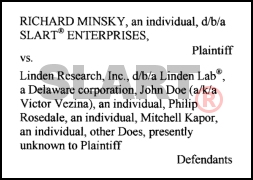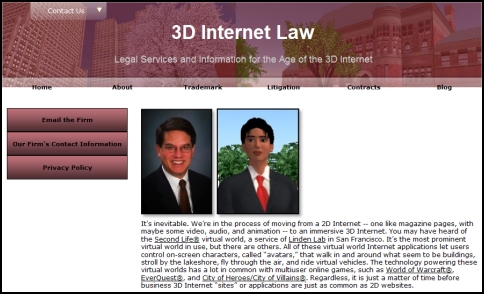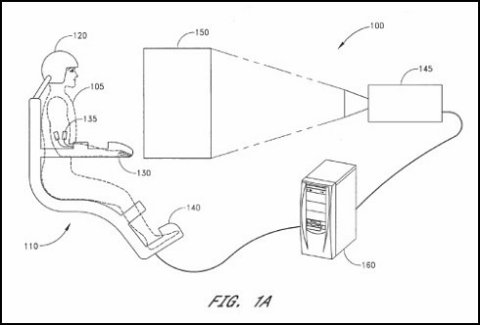September 15th, 2008 by Benjamin Duranske
 The first few weeks of the SLART trademark lawsuit between artist/”SLART” trademark registrant Richard Minsky and Linden Lab, et. al. have been busy, and culminated in a Temporary Restraining Order (TRO) by Consent (.pdf) governing Linden Lab’s short-term response to complaints about the use of “SLART” in Second Life.
The first few weeks of the SLART trademark lawsuit between artist/”SLART” trademark registrant Richard Minsky and Linden Lab, et. al. have been busy, and culminated in a Temporary Restraining Order (TRO) by Consent (.pdf) governing Linden Lab’s short-term response to complaints about the use of “SLART” in Second Life.
Minsky had originally sought (and was granted) a TRO which included provisions directing Linden Lab to stop “hiding the identities of users of its service who infringe on the SLART trademark” and stop “harassing Plaintiff with threats and/or directives to stop contacting other users,” but the Court reversed its decision after a hearing on September 10 via a docket entry, “Motion for TRO filed by Richard Minsky … The Court RESERVES decision.” The parties subsequently agreed to the current TRO by Consent.
Unless the case is terminated, the TRO by Consent will remain in force until the judge decides whether to grant a preliminary injunction, likely in late October. If granted, the preliminary injunction would then replace this TRO and remain in force until the case concludes.
For the full background of this case, see the site’s ongoing coverage of the SLART trademark lawsuit. Excerpts from the TRO and the minutes of the September 10 hearing follow.
Read the rest of the post »
Posted in Lawsuits, Linden Lab, Minsky v. Linden Lab, Providers, Second Life, Trademark Law, Virtual Law, Virtual Worlds & Games | 2 Comments »
Related Posts on Virtually Blind
September 13th, 2008 by Benjamin Duranske
Stephen Wu (California attorney, Second Life’s ‘Legal Writer’, President-Elect of the SL Bar Association, current Vice-Chair of the Section of Science & Technology Law of the American Bar Association, and the guy who put me in touch with the ABA’s publishing people about writing Virtual Law) has set up a dedicated website for his 3D internet law practice, and is writing an accompanying blog. I’m adding it to my reading list, and hope you do too.

Posted in Second Life, Virtual Law, Virtual Law Practice, Virtual Legal Education, Virtual Worlds & Games | 1 Comment »
Related Posts on Virtually Blind
September 12th, 2008 by Benjamin Duranske
I was only able to spend one day at the Virtual Worlds Expo in LA last week, but the big virtual law story was unmistakable: large U.S. law firms are starting to get more involved in 3D internet legal issues.
 Pillsbury Winthrop Shaw Pittman (sporting a spiffy new logo and single-name branding) drew the most attention for an announcement that Pillsbury is creating a practice group with a specific focus on virtual worlds. There are other firms with video game practice groups, of course, but this is a virtual worlds and video games team, and I believe it makes Pillsbury the first major U.S. law firm to specifically target the emerging 3D internet market by name. Kudos to team co-founders IP Section head James Gatto and IP partner Evan Finkel, as well as the rest of the team.
Pillsbury Winthrop Shaw Pittman (sporting a spiffy new logo and single-name branding) drew the most attention for an announcement that Pillsbury is creating a practice group with a specific focus on virtual worlds. There are other firms with video game practice groups, of course, but this is a virtual worlds and video games team, and I believe it makes Pillsbury the first major U.S. law firm to specifically target the emerging 3D internet market by name. Kudos to team co-founders IP Section head James Gatto and IP partner Evan Finkel, as well as the rest of the team.
Pillsbury’s lawyers had company; I talked to ten or fifteen other attorneys, many from big firms. Firms were even sponsoring events at the Expo this time. Latham & Watkins, the home of Roxanne Christ (Co-Chair of the Publications Subcommittee of the American Bar Association’s Special Committee on Computer Gaming and Virtual Worlds) sponsored a VIP reception for speakers at the Latham offices in Los Angeles, and Nixon Peabody sponsored lunch.
Posted in 3D Internet, Virtual Law, Virtual Law Practice | No Comments »
Related Posts on Virtually Blind
September 11th, 2008 by Benjamin Duranske
A lucky search at the USPTO turned up Patent No. 7,117,136 (.pdf) describing a whole-body input device with built-in force feedback. The patent issued to Second Life founder and former Linden Lab CEO Philip Rosedale in 2006, and has been assigned to Linden Lab.
How does it work? “An input and feedback system for use with simulator devices immobilizes a portion of the user’s body using a securement device which holds the immobilized portion in a fixed position. [...] Such immobilizing devices may be used to allow input and feedback based on the motion of various parts of the user’s body, such as the head, arms, legs, and torso.”
So basically, it’s a rudimentary holodeck, with straps and helmets. Images from the patent follow. Jokes go in the comments.

Read the rest of the post »
Posted in 3D Internet, Copyright Law, Linden Lab, Patent Law, Providers, Virtual Law | 6 Comments »
Related Posts on Virtually Blind
 The first few weeks of the SLART trademark lawsuit between artist/”SLART” trademark registrant Richard Minsky and Linden Lab, et. al. have been busy, and culminated in a Temporary Restraining Order (TRO) by Consent (.pdf) governing Linden Lab’s short-term response to complaints about the use of “SLART” in Second Life.
The first few weeks of the SLART trademark lawsuit between artist/”SLART” trademark registrant Richard Minsky and Linden Lab, et. al. have been busy, and culminated in a Temporary Restraining Order (TRO) by Consent (.pdf) governing Linden Lab’s short-term response to complaints about the use of “SLART” in Second Life.


 Pillsbury Winthrop Shaw Pittman (sporting a spiffy new logo and single-name branding) drew the most attention for an
Pillsbury Winthrop Shaw Pittman (sporting a spiffy new logo and single-name branding) drew the most attention for an 
